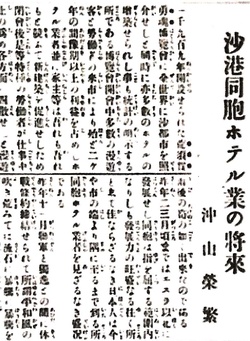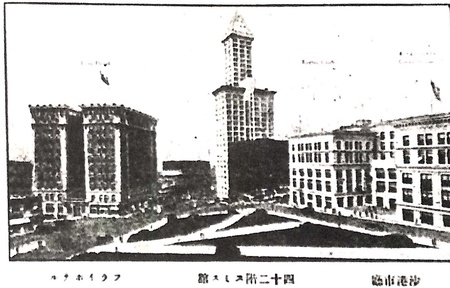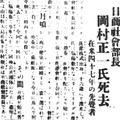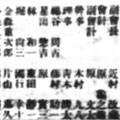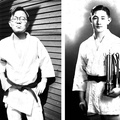In the last chapter, I introduced some historical articles about the growth of Japanese barbershop businesses in Seattle beginning in 1917. In this chapter, I discuss the development of Japanese hotel businesses in Seattle in two parts.
HISTORY OF JAPANESE HOTEL BUSINESSES
As I reported in Chapter 2, the Japanese hotel business in Seattle was started by Manjiro Morita in 1896. Beginning in 1900, the number of hotels run by Japanese continued to grow with the increase in the Seattle population. Eihan Okiyama, chairperson of the Japanese Hotel Industry Union, explained how the Japanese hotel business first flourished.
“Future of Japanese Hotel Business in Seattle” (Jan. 1, 1919 issue)
“When the City of Seattle was introduced at the Alaska-Yukon-Pacific Exposition in 1909, many hotels started to expand their holdings. Thanks to the great number of tourists and workers visiting the city during the exposition, hotel owners made more profits than they’d expected in the next two years, which enccouraged them and other property owners to build new hotels. After the exposition was over (however), these ‘special’ workers spread to different places due to the cancellation of work. With no more tourists coming in, more and more hotels became vacant, in contrast with the population at the time. With their businesses going down, hotels went bankrupt one after another, and my peers experienced the same hardship. Looking back, I think the years between 1911 and 1915 were the most economically difficult time for hotel businesses and also a time of challenge for the people involved to see if they had what it took to succeed.
“In 1916, there were some worries about workers leaving for other states as the city enforced Prohibition. However, the law changed the flow of money from being used for unproductive means to productive purposes. Hotel and restaurants owners eventually came to be at ease.
“The First World War that started in 1914 made the U.S. a manufacturer of military ships and a supplier of food products. This national economic boom had a big impact on Seattle, bringing in orders for shipbuilding. Trading with the East had its busiest days, with many workers and investors coming to Seattle like ants swarming into honey, resulting in an upswing in the hotel business, making every room full.
“Especially since the U.S. joined the war in 1917, Seattle became one of the busiest shipbuilding sites, and with bulk orders coming from the government nonstop, Caucasian workers surged from cities all around...
“It was at this time when the hotel industry experienced its biggest economic boom ever. Rooms in a hotel (normally) priced at $10 were rented at prices of $50 to $200. At one time a hotel that was valued at $10,000 dollars in the morning was ‘flown up’ with its price skyrocketing to $12,000 in the evening on the same day. An instance like this made people overnight millionaires one after another, like countless bamboo shoots popping up after rain.
“Up until around February or March of 1918, the number of Japanese hotels had increased in areas south of Yesler Street, but now their hotel businesses are making such a success that the city is full of our peers... There are over 200 hotels run by Japanese today, and if we estimate the amount of investment to be $5,000 each, the total will be over $1 million1. There is no stopping the growth of this business.”
The Frye Hotel that is on the left in the below photo was a giant hotel owned by a Caucasian. Eihan Okiyama commented in January 1, 1940 issue, “The hotel almost got in the hands of the Japanese but the plan was held back due to the ceasefire.”
THE FLOURISHING OF JAPANESE HOTEL BUSINESSES
We can see the great success of Japanese hotels beginning in 1917 in some articles of The North American Times.
“Hotel Business in Full Bloom” (Dec. 26, 1917 issue)
“Since before Christmas, hotels in the city have been extremely busy with all rooms occupied, and Caucasian workers who visit the city from the country have been forced to sleep in the open. They would go from one hotel to another, looking for rooms, and it took them forever to find a bed they could finally lie down on.”
“Hotels Run by Japanese” (Aug. 22, 1918 issue)
“The hotel business in Seattle is the Japanese pride. There is no other place in the country where the Japanese hotel business is as grown and flourishing as it is in Seattle. So far 140 hotels have joined the union, and there are 15 or 16 smaller ones in addition. Among them, 25 are located north of Yesler Way and are all luxury hotels. The total amount of money invested would probably add up to about $1 million.”
Japanese hotels in Seattle have almost outgrown Caucasian-run hotels. The 1928 edition of Hokubei Nenkan (North American Annual) reads, “In the hotel business, there are about 200 people running their hotels, and their businesses are growing bigger than ever, overwhelming their Caucasian peers – a kind of growth that cannot be seen in any other Japanese community in the U.S.”
SEATTE JAPANESE HOTEL UNION
In 1910, the hotel business union was established as Seattle ryokan (Japanese hotel) union with Chojiro Fujii as chairperson and helped nurture Japanese hotels. Fujii ran Fujii Ryokan which had 70 rooms.
“Hotel Union General Meeting” (Jan. 15, 1918 issue)
“Yesterday, the general meeting of Seattle Japanese Hotel Union, and the New Year’s gathering and farewell party for Manpei Miyagawa combined were held at Jitsugyo Club. There were a little over 50 people in attendance. Hashiguchi and Kimura each gave a farewell speech and Miyagawa gave one in response. The meeting was concluded by a dinner. The results of the board member election were as follows: Manpei Miyagawa as chairperson, Chojiro Fujii as vice chairperson, Tokio Ota as accountant, Chosaku Hashiguchi as director and 12 councilors were elected.”
Manpei Miyagawa was a member of home country observers who returned to Japan with Consul Sato on Fushimi-maru on February 9 of the same year, as I reported in Chapter 6. It was the custom back then to hold a farewell party for key figures returning to Japan.
In the North American Times column, “Ichinichi hitori hito iroiro (One Person a Day – Let Us Introduce Them)” which I described in Chapter 4, Manpei Miyagawa is featured in its February 14, 1919 issue.
“The leader of Seattle Hotel Union is a man from Kumamoto who’s known as the ‘new hotel money,’ and he has had some tough times in the hotel business. As the new rich and wars often go hand in hand, he was no exception; when he was up to his neck in debt from mutual aid financing and other causes, his business with the current Puget Hotel was his do-or-die game which brought him a chain of good luck and money, eventually making him the new rich that he became. He is quite sharp-sighted when it comes to taking the right opportunity and seeing money-making possibilities. He comes up with some solid ideas when he has money in hand.”
Manpei Miyagawa ran Puget Sound Hotel, a giant hotel with 445 rooms at the corner of the 6th street of the south Dearborn Avenue.
Note:
1. A million dollars was about two million Japanese yen back then, which is worth about two billion yen today.
*The English version of this series is a collaboration between Discover Nikkei and The North American Post, Seattle’s bilingual community newspaper. This article was originally publishd on August 13, 2022 in The North American Post.
© 2022 Ikuo Shinmasu


